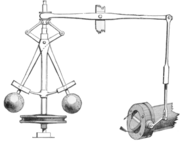
Proportional control
Encyclopedia

Feedback
Feedback describes the situation when output from an event or phenomenon in the past will influence an occurrence or occurrences of the same Feedback describes the situation when output from (or information about the result of) an event or phenomenon in the past will influence an occurrence or...
control system
Control system
A control system is a device, or set of devices to manage, command, direct or regulate the behavior of other devices or system.There are two common classes of control systems, with many variations and combinations: logic or sequential controls, and feedback or linear controls...
. Two classic mechanical examples are the toilet bowl float proportioning valve and the fly-ball governor
Centrifugal governor
A centrifugal governor is a specific type of governor that controls the speed of an engine by regulating the amount of fuel admitted, so as to maintain a near constant speed whatever the load or fuel supply conditions...
.
The proportional control system is more complex than an on-off control system like a bi-metallic domestic thermostat
Thermostat
A thermostat is the component of a control system which regulates the temperature of a system so that the system's temperature is maintained near a desired setpoint temperature. The thermostat does this by switching heating or cooling devices on or off, or regulating the flow of a heat transfer...
, but simpler than a proportional-integral-derivative
PID controller
A proportional–integral–derivative controller is a generic control loop feedback mechanism widely used in industrial control systems – a PID is the most commonly used feedback controller. A PID controller calculates an "error" value as the difference between a measured process variable and a...
(PID) control system used in something like an automobile cruise control
Cruise control
Cruise control is a system that automatically controls the speed of a motor vehicle. The system takes over the throttle of the car to maintain a steady speed as set by the driver.-History:...
. On-off control will work where the overall system has a relatively long response time, but will result in instability if the system being controlled has a rapid response time. Proportional control overcomes this by modulating the output to the controlling device, such as a continuously variable valve.
An analogy to on-off control is driving a car by applying either full power or no power and varying the duty cycle
Duty cycle
In engineering, the duty cycle of a machine or system is the time that it spends in an active state as a fraction of the total time under consideration....
, to control speed. The power would be on until the target speed is reached, and then the power would be removed, so the car reduces speed. When the speed falls below the target, with a certain hysteresis
Hysteresis
Hysteresis is the dependence of a system not just on its current environment but also on its past. This dependence arises because the system can be in more than one internal state. To predict its future evolution, either its internal state or its history must be known. If a given input alternately...
, full power would again be applied. It can be seen that this looks like pulse-width modulation
Pulse-width modulation
Pulse-width modulation , or pulse-duration modulation , is a commonly used technique for controlling power to inertial electrical devices, made practical by modern electronic power switches....
, but would obviously result in poor control and large variations in speed. The more powerful the engine; the greater the instability, the heavier the car; the greater the stability. Stability may be expressed as correlating to the power-to-weight ratio
Power-to-weight ratio
Power-to-weight ratio is a calculation commonly applied to engines and mobile power sources to enable the comparison of one unit or design to another. Power-to-weight ratio is a measurement of actual performance of any engine or power sources...
of the vehicle.
Proportional control is how most drivers control the speed of a car. If the car is at target speed and the speed increases slightly, the power is reduced slightly, or in proportion to the error (the actual versus target speed), so that the car reduces speed gradually and reaches the target point with very little, if any, "overshoot", so the result is much smoother control than on-off control.
Further refinements like PID control would help compensate for additional variables like hills, where the amount of power needed for a given speed change would vary, which would be accounted for by the integral function of the PID control.
Proportional Control Theory
In the proportional control algorithm, the controller output is proportional to the error signal, which is the difference between the set pointSetpoint
Setpoint is the target value that an automatic control system, for example PID controller, will aim to reach. For example, a boiler control system might have a temperature setpoint, that is a temperature the control system aims to attain....
and the process variable
Process variable
A process variable, process value or process parameter is the current status of a process under control. An example of this would be the temperature of a furnace. The current temperature is called the process variable, while the desired temperature is known as the set-point.Measurement of process...
. In other words, the output of a proportional controller is the multiplication product of the error signal and the proportional gain.
This can be mathematically expressed as

where
-
 : Output of the proportional controller
: Output of the proportional controller -
 : Proportional gain
: Proportional gain -
 : Instantaneous process error at time 't'.
: Instantaneous process error at time 't'. 
- SP: Set point
- PV: Process variable

